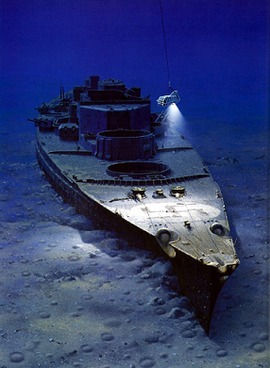In 1989, the wreckage of the Bismarck, one of Nazi Germany’s most formidable battleships, was located in the depths of the North Atlantic by Dr. Robert Ballard’s team.
Positioned nearly 4,800 meters below the ocean’s surface, the ship’s remnants provided a hauntingly preserved snapshot of its final moments and the battle it had endured.
This discovery not only resolved a decades-long maritime mystery but also offered a poignant testament to the lives lost during its last voyage in World War II.
The Last Voyage Of The Bismarck
In 1941, the Bismarck, one of Nazi Germany’s most formidable battleships, was dispatched on a mission that would ultimately prove to be its last.
Code-named Rheinübung, this operation marked the German Navy’s bold attempt to establish a presence in the North Atlantic.
The overarching objective was to wreak havoc on the Allied convoys, particularly those between North America and Britain, which were vital lifelines for the British war effort.
Setting sail from Gotenhafen (now Gdynia, Poland) on May 18, 1941, the Bismarck was accompanied by the heavy cruiser Prinz Eugen.
The two ships were tasked with slipping past British patrols, breaking out into the Atlantic, and then preying on the vulnerable merchant ships that were transporting essential supplies to the beleaguered British Isles.
If successful, this mission could have seriously jeopardized Britain’s wartime sustenance and morale.
However, British intelligence, aided by the interception and decryption of German naval communications, became privy to the plans of Rheinübung.
The Royal Navy, recognizing the threat posed by the Bismarck and its companion ship, quickly mobilized a significant portion of its fleet to intercept and neutralize the German vessels.
 The mighty Bismarck. Image by Bundesarchiv CC BY-SA 3.0 de
The mighty Bismarck. Image by Bundesarchiv CC BY-SA 3.0 de
As the Bismarck and Prinz Eugen navigated the treacherous waters between Iceland and Greenland, they encountered the British battlecruiser HMS Hood and the battleship HMS Prince of Wales.
On May 24, the two sides clashed in what would be known as the Battle of the Denmark Strait. In a tragic twist for the British, the Bismarck’s guns targeted the HMS Hood, leading to a catastrophic explosion that sank the Hood within minutes, claiming the lives of 1,415 crew members.
Only three sailors survived. Meanwhile, the HMS Prince of Wales managed to score several hits on the Bismarck but was forced to disengage due to damage.
Despite this initial success, the Bismarck did not emerge from the battle unscathed. A hit from the Prince of Wales compromised its fuel tanks, making the original mission untenable.
Moreover, the threat of a persistent British pursuit forced Admiral Günther Lütjens, the fleet commander, to make a crucial decision. Instead of pushing further into the Atlantic, he opted to head for the safety of occupied French ports for repairs.
However, the Royal Navy was relentless. Over the next couple of days, British ships and aircraft hounded the Bismarck, further damaging it and eventually rendering it nearly immobile.
By May 27, a combination of British warships, including the HMS Rodney, HMS King George V, and several cruisers and destroyers, closed in on the wounded Bismarck.
In the ensuing battle, the German battleship, though putting up a valiant defense, was overwhelmed.
With the ship severely damaged and capture imminent, the order was given to scuttle the Bismarck to prevent it from falling into British hands.
The once-mighty vessel sank, taking over 2,000 of its crew with it to the depths of the Atlantic.
The Quest To Find The Bismarck
The sinking of the Bismarck in 1941 became one of World War II’s most iconic naval moments. While the event itself was significant, the aftermath ushered in a prolonged period of mystery.
For decades, the Bismarck’s final resting place remained concealed beneath the vast, dark expanses of the North Atlantic.
The depth and size of this oceanic region, along with limited technological capabilities at the time, rendered the wreck elusive, almost akin to a maritime legend.
However, by the 1980s, as underwater exploration technology advanced, the desire to uncover this maritime mystery intensified, both for historical closure and technological accomplishment.
One of the central figures in the endeavor to locate the Bismarck was Dr. Robert Ballard, an American oceanographer and naval officer. By the late 1980s, Ballard had already earned international acclaim for his deep-sea exploration achievements.
His most significant accomplishment was the 1985 discovery of the RMS Titanic, a feat that had seemed almost impossible given the ship’s depth and the vast search area.
The successful find of the Titanic demonstrated the potential of cutting-edge underwater technology, including remotely operated vehicles (ROVs) and advanced sonar mapping systems, tools that would prove invaluable in the search for the Bismarck.
 Dr. Robert Ballard is known for his exploration of the Titanic and Bismarck.
Dr. Robert Ballard is known for his exploration of the Titanic and Bismarck.
Emboldened by the discovery of the Titanic and equipped with the lessons learned from that expedition, Ballard embarked on his new mission to locate the Bismarck.
The venture was not just about technological prowess; it was also deeply personal for Ballard. The challenge of finding a wreck that had eluded discovery for nearly 50 years was a siren call for explorers like him.
The search began in earnest in the 1980s. Given the known coordinates of the Bismarck’s last reported position and the accounts from the British ships that had engaged it, Ballard and his team had some clues to its possible location.
Yet, the North Atlantic is notoriously treacherous, with rugged underwater terrains, powerful currents, and vast depths, all of which posed significant challenges.
Ballard’s approach was systematic. Using the research vessel Knorr and leveraging sophisticated side-scan sonar, the team began to map the ocean floor around the area where the Bismarck was believed to have sunk.
This technology enabled them to identify anomalies or objects on the seabed that stood out from the natural surroundings. Given the Bismarck’s massive size, any significant structure would likely stand out in the sonar readings.
While the technical aspects of the search were challenging, they were also complemented by the human element.
Ballard’s team, consisting of oceanographers, historians, and naval experts, continuously analyzed data, cross-referenced historical accounts, and made educated guesses to refine their search patterns.
Discovery Of The Wreckage
On June 8, 1989, after exhaustive and meticulous searching, Dr. Robert Ballard’s team glimpsed a monumental revelation from the shadowy depths of the North Atlantic — the unmistakable remains of the Bismarck.
Situated nearly 4,800 meters beneath the surface, this once-mighty battleship now lay silent and defeated, but its discovery was nothing short of electrifying for both the explorers and the world at large.
Upon first sighting, what stood out was the sheer size and relatively intact condition of the Bismarck.
Despite spending decades under the crushing pressure of the deep sea and being subjected to the corrosive effects of saltwater, the ship’s colossal frame appeared eerily preserved.
The battleship lay upright, with many of its primary features — like the mammoth gun turrets — still discernible. This state of preservation was a testament to the German naval engineering prowess and the quality of materials used in its construction.
Using deep-sea submersibles equipped with cameras and lights, Ballard and his team set about documenting the wreck in detail.
These submersibles, remotely operated from the surface, were capable of maneuvering around the ship, enabling the team to capture comprehensive and intricate visuals.
As the images streamed to the surface, the Bismarck began revealing its secrets.

An illustration of Ballard’s ROV ‘Argo’ exploring the wreckage of the Bismarck.
The footage showcased extensive battle damage, indicative of the fierce engagement the Bismarck had endured during its last hours.
Massive punctures, twisted steel plates, and contorted artillery placements painted a vivid picture of the onslaught it had faced from the British fleet.
For naval historians and experts, these images provided invaluable insights into the tactics employed during the battle and the effectiveness of wartime weaponry.
However, amidst the evident external battle scars, the explorers also observed something that substantiated long-held beliefs.
They noted that several of the Bismarck’s seacocks — valves on the ship’s lower hull — appeared to have been deliberately opened.
This discovery lent credence to the accounts suggesting that the ship’s crew had intentionally scuttled the Bismarck to prevent its capture.
The sight of these opened flood valves not only supported the narrative of the ship’s deliberate sinking but also underscored the determination of its crew to ensure that their prized vessel would never fall into enemy hands.
Beyond the tangible details of the ship’s structure and damage, the discovery and subsequent examination of the Bismarck also evoked profound emotions.
For many, it served as a poignant reminder of the lives lost during its sinking. While the ship itself was a marvel of engineering, it was, more importantly, a tomb for over 2,000 sailors.
Their sacrifice and the tragic narrative of the ship’s last voyage echoed in the silent corridors and chambers of the sunken behemoth.
News
A Creative Journey: Lady Gaga’s Artistic Growth and Fearless Embrace of Individuality
The weirdness and craziness of star Lady Gaga’s outfits have been increasing every day. Even if she were dressed in rags and beggar clothes, no one would be surprised. Lady Gaga created her own unique, shocking fashion line that no…
Gaga’s Street Style: No Bras, Semi-Sheer Top, and Daring Daisy Dukes in NYC
Lady Gaga recently unveiled the much-anticipated track list for her latest album, Joanne, and she is certainly not shying away from the limelight. The singer was spotted in New York on Saturday confidently flaunting her unique fashion sense. Her daring…
VIDEO : Unexpected Flashback: Old Footage Resurfaces Showing Lady Gaga’s Unusual On-Stage Act with a Girl Vomiting on Her Chest
It’s come back up. A clip of a woman making herself vomit on Lady Gaga during her SXSW performance in 2014 has resurfaced online — and the bile hasn’t aged well. Gaga, 36, incorporated performance artist Millie Brown into her choreography…
My First Piano Teacher Was a Stripper’: Lady Gaga Reveals Dad Hired a Stripper as Her Music Teacher, Linking it to Her Signature Long Nails
Lady Gaga is one of the popular artists who’s known for image reinventions and musical versatility. She rose to fame with her debut studio album, The Fame in 2007 with its chart-topping singles Just Dance and Poker Face. She is not only…
20 Bizarre Photos Prove That Lady Gaga Is The Most Unhinged Fashion Icon Ever
One of the most iconic and multi-talented artists of our time, Lady Gaga, with worldwide hits such as Bad Romance, Judas, and Born This Way, is also known as a composer, an actress, and above all, a fashionista. Known as…
Lady Gaga Goes Makeup-Free for Oscars Performance, Letting People See the Real Her
Oscars executive producer reveals Lady Gaga decided to go makeup-free during her performance to show people the ‘real’ her. Featured Image Credit: ABC Yesterday (March 13), the musician stunned viewers with a performance of the Oscar-nominated song ‘Hold My Hand’…
End of content
No more pages to load











